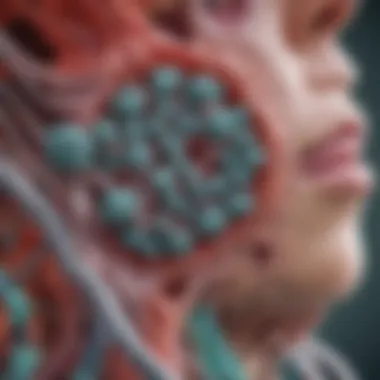Pfizer RSV Vaccine: Efficacy and Public Health Impact


Intro
The development of the Pfizer RSV vaccine represents a significant step forward in the fight against Respiratory Syncytial Virus (RSV). RSV is well-known as a leading cause of respiratory infections in infants and young children. The urgency surrounding vaccine development has been propelled by the virus's impact on public health.
In recent years, Pfizer invested substantial resources into research on the vaccine. This comprehensive initiative combines advanced scientific inquiry and clinical testing to gauge effectiveness. Evaluating both the efficacy and safety profile of the vaccine is paramount in understanding its potential role in preventive health measures. Furthermore, this exploration will delve into the implications of the vaccine on public health, accessibility concerns, and future directions for research in vaccinology.
The need for this in-depth exploration is clear. Understanding the complexities of vaccine development, particularly for a virus like RSV, is crucial for healthcare professionals, researchers, and policymakers. With potential global health impacts, a well-rounded grasp of the process involved in creating and distributing the Pfizer RSV vaccine is essential.
Preamble to RSV
Understanding the Respiratory Syncytial Virus (RSV) is crucial for grasping the broader implications of vaccine development, particularly the Pfizer RSV vaccine. RSV is a significant pathogen known for its role in respiratory infections, particularly in infants and the elderly. Its prevalence and potential to cause severe health complications necessitate an in-depth exploration.
Understanding Respiratory Syncytial Virus
Respiratory Syncytial Virus, commonly referred to as RSV, primarily affects the respiratory system. It is a leading cause of bronchiolitis and pneumonia in young children. The virus spreads through respiratory droplets when an infected person coughs or sneezes. RSV is particularly dangerous for infants, preterm babies, and those with underlying health conditions. Symptoms range from mild cold-like signs to severe respiratory distress. This variability in symptoms can lead to misdiagnosis and delayed treatment, contributing to higher hospitalization rates during RSV outbreaks.
The virus has two main forms: the A and B strains, with each having different clinical implications. Strain A is often associated with more severe disease, particularly in vulnerable populations. Understanding these elements is essential for developing effective vaccination strategies, such as the Pfizer RSV vaccine, which aims to bolster the immune responses against these prevalent strains.
Epidemiology and Impact of RSV
The impact of RSV extends beyond individual health concerns; it poses a significant burden on public health systems worldwide. According to the World Health Organization, RSV infections lead to several million hospitalizations annually, especially among infants under the age of five. The virus circulates globally, typically causing seasonal outbreaks in the late fall and winter months.
Key points about the epidemiology of RSV include:
- Global Incidence: Over 64 million cases are reported each year.
- Age Vulnerability: Children under one year old have the highest hospitalization rates.
- Economic Burden: Healthcare costs related to RSV can be substantial, impacting families and healthcare systems alike.
The profound impact of RSV on vulnerable populations underscores the urgent need for an effective vaccine, making the Pfizer RSV vaccine not just a scientific achievement but a potential public health milestone.
In summary, the understanding of RSV’s nature and epidemiology forms the foundation for discussions surrounding vaccine development and deployment. This knowledge is essential for contextualizing the Pfizer RSV vaccine’s roles and assessed benefits.
The Pfizer RSV Vaccine: An Overview
The development of the Pfizer RSV vaccine represents a significant milestone in the fight against Respiratory Syncytial Virus (RSV). This vaccine aims to mitigate the impact of RSV, a virus that poses severe health risks particularly to infants and the elderly. Understanding the overview of this vaccine is crucial as it lays a foundation for discussions related to its development, efficacy, and broader public health implications.
Development Timeline
The development of the Pfizer RSV vaccine has been systematic, with each phase marked by rigorous scientific inquiry. Key milestones include the initial preclinical studies, where the vaccine's potential was assessed. Following this, early-phase clinical trials were launched in response to promising results. These trials tested various dosages and evaluated safety in a controlled environment. Throughout this timeline, interactions with regulatory authorities provided vital feedback, shaping the vaccine’s development journey. As the process moved forward, comprehensive data collection became paramount for justifying subsequent trial phases.
- Preclinical Studies (Year X): Initial animal studies focused on safety and immune response.
- Phase I Trials (Year Y): Aimed at establishing safety in a small group.
- Phase II Trials (Year Z): Expanded to more diverse populations, testing dosage and efficacy.
By the conclusion of these phases, Pfizer had gathered substantial data reflecting both the vaccine's promise and its potential for future implementation.
Research and Development Process
The research and development of the Pfizer RSV vaccine was a multifaceted process, combining cutting-edge science with strategic decision-making. The efforts were deeply rooted in understanding the viral structure of RSV, which informed vaccine design. Pfizer employed a blend of traditional and innovative technologies, working with platforms that stimulate an immune response without exposing participants to active virus.
Critical to this process was the collaboration with various stakeholders, including healthcare professionals and regulatory bodies. This teamwork ensured that the research adhered to the highest ethical and scientific standards throughout. Furthermore, extensive data analysis was integral in determining the optimal parameters for efficacy and safety, laying the groundwork for future trials and eventual rollout.
The Pfizer RSV vaccine's development is emblematic of modern approaches in vaccine science. It not only addresses an urgent public health need but also sets a precedent for future vaccine innovations.
Mechanism of Action
Understanding the mechanism of action of the Pfizer RSV vaccine is crucial to grasp the biological principles that underlie its design and effectiveness. The mechanism of action delineates how the vaccine elicits an immune response and offers protection against Respiratory Syncytial Virus. Key components of this mechanism provide insights into its composition and the subsequent immune induction it initiates.


Vaccine Composition
The Pfizer RSV vaccine is designed to induce an immune response effectively while ensuring safety. It primarily incorporates a stabilized version of the pre-fusion form of the RSV F protein. This protein plays a significant role in the virus's ability to infect human cells. The use of the pre-fusion F protein is crucial because it mimics the natural structure that RSV uses to invade cells, promoting a stronger immune response.
Additionally, the vaccine may include adjuvants, which are substances that enhance the body's immune response to an antigen. The inclusion of these components enhances the efficacy of the vaccine, making it a promising candidate for widespread immunization.
Biologically, the vaccine’s composition is tailored to provoke both humoral and cellular immunity, factors vital for comprehensive protection against RSV in affected populations.
Immune Response Induction
The process of immune response induction by the Pfizer RSV vaccine involves the activation of specific immune cells after vaccination. Once the vaccine is administered, it triggers the body to recognize the modified RSV proteins. Subsequently, B cells produce antibodies specific to these proteins, offering immediate protection against the virus.
Moreover, T cells become activated as well, enhancing the immune response's depth and longevity. These T cells can identify and destroy RSV-infected cells, providing essential defense against future infections.
The dual action of B and T cell activation is crucial for achieving both immediate and long-lasting immunity to RSV.
The immune response resulting from this induction not only helps in fighting off current infections but also prepares the immune system for future encounters with RSV.
Clinical Trials and Efficacy
Clinical trials are a critical component of vaccine development, determining both the safety and efficacy of new medical interventions. In the case of the Pfizer RSV vaccine, rigorous clinical trials have been conducted to assess its performance against Respiratory Syncytial Virus. This section will explore the phases of clinical trials and the interpretation of their efficacy results. Understanding these elements provides insights into why careful testing is essential before a vaccine can be approved for public use.
Phases of Clinical Trials
Clinical trials are typically conducted in phases, each with distinct objectives and methodologies. The Pfizer RSV vaccine underwent three primary phases: Phase 1, Phase 2, and Phase 3.
Phase 1: This initial phase involves a small group of volunteers, often healthy individuals. Here, the main focus is on determining the vaccine's safety and identifying any potential side effects. Researchers also assess appropriate dosage levels.
Phase 2: In this phase, the trials expand to a larger group, including individuals from various demographics. This helps to evaluate the immune response and gather further safety data. Data collected here also help refine the dosage if needed.
Phase 3: The vaccine is administered to thousands of participants across multiple locations. This phase is critical for evaluating the vaccine's effectiveness in preventing RSV infections. Researchers compare infection rates between those who received the vaccine and those who did not, providing robust data on its efficacy.
Efficacy Results and Interpretation
The results from the clinical trials are crucial for understanding how effective the Pfizer RSV vaccine is against the virus. Efficacy is typically measured by the reduction in disease incidence among vaccinated participants compared to unvaccinated controls. In the clinical trials for the Pfizer RSV vaccine, results showed a promising efficacy rate.
A significant reduction in RSV cases among vaccinated individuals highlighted the vaccine's capability to induce a strong immune response. These outcomes are interpreted not only in terms of numbers but also in the context of public health. A vaccine with high efficacy can lead to fewer hospitalizations and serious complications related to RSV, particularly in vulnerable populations such as infants and the elderly.
"The evaluation of clinical trial data is more than numbers; it reflects the potential to make significant advancements in public health."
Thus, through multiple phases of clinical trials and careful analysis of efficacy results, the Pfizer RSV vaccine has shown great promise. Subsequent regulatory considerations will continue to build on this foundation, paving the way for its global deployment.
Safety Profile
The safety profile of the Pfizer RSV vaccine is crucial in assessing its overall viability for widespread use. As with any vaccine, understanding potential risks is fundamental for public acceptance and informed decision-making. An effective vaccine must not only provide protection against the disease but also do so with minimal adverse effects. The ongoing evaluation of the safety profile allows researchers and health regulators to monitor any unexpected reactions or long-term implications.
Adverse Effects Reported
Clinical trials of the Pfizer RSV vaccine have reported various adverse effects. Most reactions are generally mild to moderate and resolve quickly. Commonly observed adverse effects include:
- Injection site reactions: Pain, redness, or swelling at the injection site.
- Systemic reactions: Fever, fatigue, muscle aches, and headache.
- Allergic reactions: Though rare, some participants have experienced allergic reactions ranging from mild rashes to anaphylaxis.
It is important to collect and report these adverse effects as they play a significant role in understanding how the vaccine interacts with different demographics. Continuous monitoring post-approval will further illuminate any rarer side effects that were not captured during clinical trials.
Comparative Safety Assessment
A comparative safety assessment of the Pfizer RSV vaccine involves analyzing its safety profile against other vaccines on the market. This comparison helps in establishing its reliability and efficacy. For instance, when looking at established vaccines like the influenza vaccine or the COVID-19 vaccines from Moderna or Johnson & Johnson, we can make several observations.


- Incidence of Adverse Effects: While some vaccines may report higher rates of severe reactions, Pfizer's RSV vaccine has generally shown a favorable safety outcome, with most issues being mild.
- Long-term Safety: Understanding long-term effects is a vital focus area. Historical data from previous vaccines provide benchmarks for expected side effects.
- Diversity in Patient Populations: Assessing how different populations react to the vaccine can yield vital insights. For example, older adults and those with pre-existing conditions may have different risk profiles.
"Vaccine safety monitoring is an ongoing process that extends beyond the approval of a vaccine. It incorporates real-world data to ensure the public remains informed and confident."
Safeguarding public health relies on transparency regarding safety assessments and effectiveness. By prioritizing these evaluations, we work towards achieving broad and informed vaccine acceptance.
Regulatory Considerations
The segment of regulatory considerations is crucial in understanding the Pfizer RSV vaccine. This area encompasses the processes required for vaccine approval and the challenges faced in different geographical regions. The importance of regulatory aspects cannot be understated, as they safeguard public health while ensuring that vaccines reach patients efficiently.
Approval Process Overview
The approval process for vaccines usually involves several stages, aimed at ensuring safety and efficacy. For the Pfizer RSV vaccine, this path began with preclinical studies. These studies assess the vaccine's effects in laboratory settings and animal models. After generating sufficient data, developers progress to clinical trials.
Clinical trials are divided into phases, each with specific objectives:
- Phase 1: Focuses on safety, involving a small group of healthy volunteers.
- Phase 2: Tests efficacy and side effects in a larger group.
- Phase 3: Involves thousands of participants to thoroughly evaluate the vaccine's performance.
Upon successful completion of these phases, the data is submitted to regulatory bodies, such as the U.S. Food and Drug Administration (FDA) or the European Medicines Agency (EMA). These organizations review the evidence and decide on vaccine approval. A swift review process can lead to Emergency Use Authorization, facilitating quicker access for vulnerable populations.
"Regulatory frameworks need to adapt swiftly to emerging health threats, especially when it comes to infectious disease vaccines."
Global Regulatory Challenges
When looking at vaccine approval, global regulatory challenges arise. Different regions have varying standards. This discrepancy affects how quickly a vaccine can be distributed worldwide. Some of the primary challenges include:
- Diverse Regulatory Frameworks: Each country operates under its own guidelines and protocols. This leads to inconsistencies in approval timelines.
- Cultural and Societal Factors: Trust in vaccines varies across populations, influencing the regulatory approach.
- Political and Legal Barriers: In some regions, political considerations can hinder the rapid approval of health initiatives.
Overcoming these challenges requires international cooperation and the establishment of harmonized guidelines. Only then can the benefits of innovative vaccines, like the Pfizer RSV vaccine, be fully realized. Successful navigation of the regulatory landscape will also pave the way for future advances in vaccine development.
Public Health Implications
The public health implications of the Pfizer RSV vaccine are substantial and warrant detailed discussion. These implications extend beyond immediate health benefits, potentially reshaping health policies and practices globally. Understanding the efficacy and uptake of this vaccine can aid in controlling the spread of Respiratory Syncytial Virus (RSV). As RSV significantly impacts young children and the elderly, prioritizing this vaccine could greatly reduce hospitalizations and healthcare burdens.
Impact on Global Health
The impact of the Pfizer RSV vaccine on global health is profound. With nearly 3 million hospitalizations and over 100,000 deaths attributed to RSV annually, vaccine deployment can significantly curb these figures. Some key points include:
- Reducing Mortality Rates: Enhanced vaccination can target vulnerable populations, notably infants and the elderly, leading to decreased mortality.
- Economic Burdens: Lower hospitalization rates might translate to reduced healthcare costs. This is especially crucial in low-income regions where healthcare resources are limited.
- Herd Immunity: Widespread vaccinations may also contribute to herd immunity, thereby protecting those who are unvaccinated or have compromised immune systems.
Vaccination Strategies and Recommendations
Effective vaccination strategies are essential to ensuring the successful implementation of the Pfizer RSV vaccine. Various aspects should be examined to optimize population coverage and efficacy:
- Targeted Campaigns: Public health campaigns should focus on educating caregivers about RSV risks. Information on the availability and benefits of the vaccine should be easily accessible.
- Accessibility to Diverse Population: Programs must ensure that the vaccine is distributed in both urban and rural settings, maximizing outreach.
- Collaboration with Health Organizations: Partnering with local health organizations can enhance distribution and education efforts, ensuring that the vaccine reaches those most at risk.
The development of a coherent strategy is vital for maximizing the public health benefits of the Pfizer RSV vaccine.
In summary, these strategies should be adaptable and responsive to evolving population health needs, ensuring the vaccine's benefits are fully realized. Both public awareness and logistical efficiency will be critical to the vaccination campaign's success.
Accessibility and Distribution
Accessibility and distribution are critical elements in the implementation of the Pfizer RSV vaccine. Vaccines are only effective if they reach the populations most in need. As respiratory syncytial virus (RSV) primarily affects infants and older adults, it is essential to ensure that these vulnerable groups can access the vaccine easily. Furthermore, understanding accessibility involves looking beyond the availability of the product. It encompasses factors such as economic barriers, geographical disparities, and healthcare infrastructure. Failing to address these aspects can lead to unequal health outcomes, which is counterproductive in a global health initiative.


Equity in Distribution
Equity in distribution means that all populations should have an equal opportunity to receive the RSV vaccine. This includes individuals in low-income regions or those without easy access to healthcare facilities. The challenges can be steep. Disparities in wealth often correlate with differences in vaccine access.
To promote equitable access, several strategies can be implemented:
- Price Controls: Governments and organizations can negotiate prices to make vaccines more affordable.
- Partnerships: Collaborating with local healthcare providers can enhance outreach to underserved communities.
- Public Awareness Campaigns: Raising awareness can drive vaccine uptake, especially in populations skeptical about vaccinations.
Understanding equity in distribution is vital to ensuring that the impact of the vaccine is maximized across all demographics. It also fosters trust in public health initiatives.
Logistical Challenges
Logistical challenges are inherent in the distribution of any vaccine, including the Pfizer RSV vaccine. These challenges can stem from multiple sources and can impede timely delivery of the vaccine to those who need it most. Key logistical issues include:
- Cold Chain Requirements: Vaccines often need to be stored at specific temperatures, which can be difficult in many regions, particularly where infrastructure is lacking.
- Transportation: Reaching remote areas often requires special transportation methods that may not be readily available.
- Regulatory Compliance: Different countries have various regulations that must be adhered to, which can slow down the distribution process.
Efforts to mitigate these logistical challenges are crucial for maximizing the reach of the RSV vaccine. Approaches may involve leveraging technology, investing in infrastructure, and ensuring coordination among stakeholders in the supply chain. By addressing these challenges, the potential public health benefits of the Pfizer RSV vaccine can be realized more fully.
Future Directions in RSV Vaccine Development
The exploration of future directions in the development of respiratory syncytial virus (RSV) vaccines is critical as the global health landscape evolves. Understanding new avenues for research and vaccine strategies can significantly influence public health outcomes and enhance preparedness against RSV infections. Considering the impact of RSV, especially in vulnerable populations such as infants and the elderly, continuous innovation in vaccine development is essential.
Innovative Approaches
Research into innovative approaches for RSV vaccine development is gaining traction. These new methodologies seek to address limitations seen in traditional vaccine strategies. Here are some key approaches being considered:
- mRNA Technology: Harnessing the advancements in mRNA technology could allow for more flexible and rapid vaccine responses. This approach was seen during the COVID-19 pandemic, showing promise in inducing strong immune responses with potentially fewer side effects.
- Viral Vector Vaccines: Utilizing viral vectors to deliver RSV antigens is another promising strategy. Viral vectors can elicit robust immune responses by presenting the viral proteins in a way that closely mimics a natural infection.
- Protein Subunit Vaccines: This method involves using purified protein antigens from the RSV virus, which could lead to increased immunogenicity and safety. Developing such vaccines could minimize adverse effects while maximizing efficacy.
These innovative approaches aim to tailor vaccines to provide better immunity, safety, and accessibility across diverse populations.
Research Gaps and Opportunities
Despite advancements, numerous research gaps remain in the study of RSV vaccines. Identifying these gaps can reveal critical opportunities for future investigations. Here are notable areas to explore:
- Understanding Immunity: There is a need for better comprehension of the immune responses specific to RSV. Assessing the duration and quality of immunity provided by existing vaccine candidates is vital.
- High-Risk Populations: Research must focus on developing vaccines tailored for high-risk groups. Understanding how the immune response varies in infants, elderly, and immunocompromised individuals can guide effective vaccine design.
- Global Access and Integration: Evaluating how to effectively integrate new RSV vaccines into existing healthcare frameworks globally is essential. Exploring collaboration with organizations like the World Health Organization could enhance distribution strategies and affordability.
Addressing these gaps not only fosters scientific advancements but also ensures that new vaccines can meet the needs of all demographic groups.
In summary, the future of RSV vaccine development is ripe with potential. By embracing innovative approaches and strategically addressing research gaps, we can pave the way to effective solutions against RSV while contributing to the broader field of vaccinology.
Epilogue
The conclusion of this article emphasizes the importance of the Pfizer RSV vaccine within the larger context of public health. This topic is of significant relevance, given the severe implications of Respiratory Syncytial Virus on vulnerable populations, especially infants and the elderly. The vaccine presents a promising advancement in combating RSV, potentially reducing hospitalization rates and mortality associated with this virus.
Summary of Findings
Throughout this exploration, several key findings emerge regarding the Pfizer RSV vaccine:
- Efficacy: Clinical trials have demonstrated the vaccine's potential effectiveness in various demographics, highlighting its role in preventing RSV infections. The trials provide robust data supporting the vaccine’s use.
- Safety: Adverse events associated with the vaccine are mostly mild and manageable. The safety profile is comparatively favorable, laying a strong foundation for its acceptance among healthcare providers.
- Regulatory Approvals: Rapid regulatory pathways adopted by health authorities enable timely access to vaccine deployment. Understanding these processes can inform future vaccine strategies.
- Global Impact: The vaccine's introduction could alleviate the RSV burden on healthcare systems globally, promoting healthier outcomes for at-risk populations.
By focusing on these areas, the article provides a clear view of the vaccine's implications for individuals and communities, addressing both scientific and practical aspects.
Final Thoughts on the Pfizer RSV Vaccine
In summary, the Pfizer RSV vaccine represents a significant milestone in the field of vaccinology. Its development reflects an earnest response to an ongoing public health challenge. As research evolves, continuous assessment of the vaccine's effectiveness and safety will be vital to sustaining its success.
Furthermore, considering accessibility and logistical issues ensures that the vaccine reaches those who need it most. Future research could explore enhancement of vaccine formulations and alternative delivery mechanisms to improve immunization rates. As such, this vaccine heralds a new chapter in the fight against RSV, offering hope and solutions to disrupt the cycle of infection and its associated health burdens.
"The battle against Respiratory Syncytial Virus can only be won through comprehensive strategies that include vaccination, public awareness, and equitable access to healthcare resources."
The overall landscape for RSV prevention is vastly changing, and the Pfizer RSV vaccine is a crucial part of this narrative.



